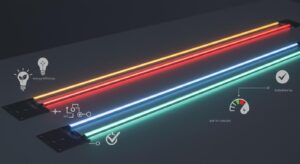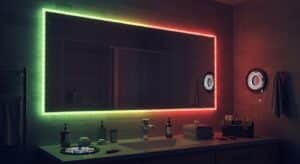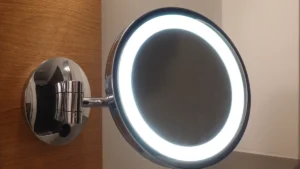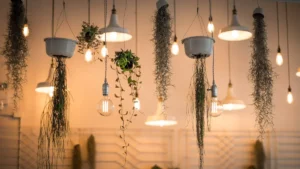
LED modules have revolutionized the way you think about lighting. These compact, energy-efficient units provide a modern solution for countless applications, from home decor to industrial setups. They consume about 75% less electricity than traditional bulbs and last up to 25 times longer, saving you money while reducing your carbon footprint. Their versatility makes them perfect for creative projects, whether you’re designing wearable tech or crafting unique holiday displays. With their ease of use, even beginners can dive into the world of LED modules and unlock endless possibilities for innovation.
Key Takeaways
LED modules are energy-efficient lighting solutions that consume 75% less electricity and last up to 25 times longer than traditional bulbs, making them a cost-effective choice.
Understanding the key components of LED modules, such as LEDs, circuit boards, and connectors, is crucial for maximizing their potential in various applications.
Proper tools and materials, including soldering irons, wire strippers, and multimeters, are essential for successfully connecting and troubleshooting LED modules.
LED modules can be used creatively in home lighting, wearable technology, and holiday decorations, offering endless possibilities for innovation and design.
Testing connections with a multimeter can help identify issues like flickering or no light, ensuring your LED module setup functions reliably.
For beginners, using solderless connectors simplifies the installation process, making it easier to create light-up projects without advanced skills.
Exploring the versatility of LED modules can lead to exciting projects, from enhancing home decor to upgrading automotive lighting, empowering you to bring your creative visions to life.
Understanding LED Modules

LED modules are at the heart of modern lighting solutions. They combine advanced technology with practical design, making them a go-to choice for various applications. Whether you’re upgrading your home lighting or working on a creative DIY project, understanding these modules will help you make the most of their potential.
What Are LED Modules?
LED modules are compact units that house one or more light-emitting diodes (LEDs). These modules are pre-assembled and ready to use, which makes them beginner-friendly. Unlike traditional bulbs, they offer better energy efficiency, longer lifespans, and greater flexibility in design. You can find them in everything from architectural lighting to wearable tech. Their ability to adapt to different shapes and surfaces makes them ideal for both functional and decorative purposes.
Key Components of LED Modules
To fully appreciate LED modules, it’s essential to understand their main components. Each part plays a crucial role in their performance and versatility.
LEDs (Light Emitting Diodes)
The LED is the core of every module. It converts electrical energy into light with minimal heat loss. LEDs are known for their durability and efficiency, lasting much longer than traditional light sources. They also come in various colors and brightness levels, giving you plenty of options for customization.
Circuit Board and Housing
The circuit board holds the LEDs and ensures proper electrical connections. It’s often paired with a durable housing that protects the module from damage. Some modules, like flexible LED modules, use a bendable substrate, allowing you to install them on curved or uneven surfaces. This feature is particularly useful in industries like automotive and advertising, where unique designs are essential.
Connectors and Wiring
Connectors and wiring make it easy to integrate LED modules into your projects. They allow you to link multiple modules together or connect them to a power source. Some modules even come with solderless connectors, simplifying the installation process for beginners. Proper wiring ensures consistent performance and prevents issues like flickering or overheating.
Benefits of LED Modules
LED modules offer a range of advantages that make them stand out from other lighting options. Here are some key benefits you can enjoy.
Energy Efficiency and Longevity
LED modules consume significantly less energy than traditional lighting. They reduce electricity costs and have a much longer lifespan, often lasting up to 50,000 hours or more. This means fewer replacements and less waste, making them an eco-friendly choice. For example, COB LED modules provide high lumen output while maintaining excellent energy efficiency, making them perfect for industrial and architectural applications.
Versatility in Applications
The versatility of LED modules is unmatched. You can use them for home lighting, outdoor decorations, or even automotive upgrades. Products like outdoor LED modules are designed to withstand harsh weather, making them ideal for streetlights and parking lot lighting. Meanwhile, LED light modules are perfect for accentuating indoor spaces, creating eye-catching displays, or enhancing vehicle interiors. Their adaptability allows you to explore endless creative possibilities.
Tools and Materials for Connecting LED Modules
When working with LED modules, having the right tools and materials ensures a smooth and efficient setup. Whether you’re a beginner or an experienced DIY enthusiast, this section will guide you through the essentials and optional tools that can elevate your projects.
Essential Tools
To connect LED modules effectively, you’ll need a few basic tools. These tools make the process easier and help you achieve reliable connections.
Soldering Iron or Solderless Connectors
A soldering iron is a must-have if you plan to create permanent and secure connections. It allows you to attach wires to the LED module with precision. For beginners or those who prefer a simpler approach, solderless connectors are a fantastic alternative. These connectors let you link wires without the need for heat, making them safer and quicker to use.
Wire Strippers and Cutters
Wire strippers and cutters are essential for preparing your wires. They help you remove the insulation from the wire ends and cut them to the desired length. Properly stripped wires ensure a solid connection, reducing the risk of loose or faulty wiring.
Multimeter for Testing Connections
A multimeter is a handy tool for checking your connections. It helps you measure voltage, current, and resistance, ensuring everything is functioning as it should. Use it to troubleshoot issues like flickering lights or no power reaching the module.
Required Materials
Gathering the right materials is just as important as having the right tools. These items form the foundation of your LED module setup.
LED Modules
The LED module is the star of your project. These compact units house multiple LED chips mounted on a substrate, offering uniform illumination and easy integration. Choose modules that suit your project’s needs, whether it’s for home lighting, signage, or wearable tech.
Power Supply (e.g., batteries or adapters)
A compatible power supply is crucial for powering your LED modules. Options include batteries for portable setups or adapters for stationary installations. Ensure the voltage and current match the requirements of your LED module to avoid damage.
Wires and Connectors
Wires and connectors link your LED modules to the power supply. Use high-quality wires to ensure consistent performance. Some LED modules come with pre-attached connectors, simplifying the installation process.
Resistors (if needed)
Resistors help regulate the current flowing through your LED modules. They prevent overheating and extend the lifespan of your LEDs. Check your module’s specifications to determine if resistors are necessary.
Optional Tools for Advanced Projects
If you’re looking to take your LED module projects to the next level, consider adding these advanced tools to your toolkit.
Microcontrollers (e.g., Arduino or Raspberry Pi)
Microcontrollers like Arduino or Raspberry Pi allow you to program and control your LED modules. They’re perfect for creating dynamic lighting effects, such as color-changing patterns or synchronized displays.
RGB Controllers for Color LEDs
RGB controllers let you adjust the colors and brightness of your LED modules. They’re ideal for projects involving color LEDs, giving you full control over the lighting ambiance.
Pro Tip: Always double-check the compatibility of your tools and materials with your LED modules. This ensures a seamless setup and prevents potential issues during installation.
By equipping yourself with these tools and materials, you’ll be ready to tackle any LED module project with confidence. Whether you’re creating a simple lighting setup or an advanced programmable display, the right preparation makes all the difference.
Step-by-Step Guide to Connecting LED Modules
Connecting LED modules might seem tricky at first, but with the right steps, you’ll find it straightforward and rewarding. This guide will walk you through the process, ensuring your setup works efficiently and safely.
Preparing the Components
Before diving into the wiring, take a moment to prepare everything you’ll need. Proper preparation ensures a smooth installation process.
Inspecting the LED Module and Power Supply
Start by examining your LED module and power supply. Check for any visible damage, such as cracks or loose wires. Ensure the module is compatible with your power supply in terms of voltage and current. Mismatched components can lead to performance issues or even damage. If your module includes a circuit board, confirm that all connections are intact. A quick inspection now can save you from troubleshooting later.
Cutting and Stripping Wires
Next, prepare your wires. Use wire cutters to trim them to the appropriate length for your setup. Avoid leaving excess wire, as it can create clutter and increase the risk of short circuits. After cutting, strip about half an inch of insulation from each end using wire strippers. This exposes the copper core, which is essential for creating a solid connection. Make sure the stripped ends are clean and free of frayed strands.
Wiring the LED Module
With your components ready, it’s time to connect the LED module. Follow these steps to ensure a secure and functional setup.
Connecting Positive and Negative Wires
Identify the positive and negative terminals on your LED module. These are usually marked with “+” and “-” symbols. Connect the positive wire from your power supply to the positive terminal of the module. Do the same for the negative wire. Always double-check the polarity before proceeding. Reversing the connections can damage the module or prevent it from working.
Using Solder or Solderless Connectors
For a permanent connection, use a soldering iron to attach the wires to the module. Apply a small amount of solder to secure the connection. If you’re new to soldering or prefer a quicker method, opt for solderless connectors. These handy tools let you attach wires without heat, making them ideal for beginners. Whichever method you choose, ensure the connections are tight and stable.
Setting Up the Power Supply
Once the wiring is complete, focus on the power supply. A proper setup ensures your LED module operates safely and efficiently.
Choosing the Right Voltage and Current
Select a power supply that matches the voltage and current requirements of your LED module. Using a supply with the wrong specifications can cause flickering, overheating, or even permanent damage. If you’re unsure, refer to the module’s documentation or consult the manufacturer. For added safety, consider using a constant current LED driver. It adjusts the output voltage to meet the module’s needs, ensuring consistent performance.
Connecting the Power Source to the Module
Finally, connect the power supply to your LED module. Attach the positive and negative wires from the supply to the corresponding terminals on the module. Secure the connections to prevent them from coming loose. Once everything is in place, plug in the power supply and test the module. If it lights up as expected, you’ve successfully completed the setup.
Pro Tip: Always test your connections with a multimeter before powering up. This helps identify any issues, such as loose wires or incorrect polarity, and prevents potential damage.
By following these steps, you’ll have your LED module up and running in no time. Whether you’re lighting up a room or creating a custom display, this process ensures a reliable and efficient setup.
Testing and Troubleshooting
Even with careful preparation and wiring, issues can arise when connecting LED modules. Testing and troubleshooting help you identify and fix problems, ensuring your setup works flawlessly. Let’s dive into the steps to check your connections and resolve common issues.
Checking Connections with a Multimeter
A multimeter is your best friend when it comes to testing LED module connections. It helps you verify that everything is wired correctly and functioning as expected. Here’s how you can use it:
Set the Multimeter: Turn your multimeter to the voltage or continuity setting, depending on what you want to test. For checking power flow, use the voltage setting. To confirm proper connections, use the continuity mode.
Test the Power Supply: Place the multimeter probes on the positive and negative terminals of your power supply. Ensure the voltage matches the requirements of your LED module. If the reading is off, your power supply might be the issue.
Check the Wiring: Touch the probes to the positive and negative wires connected to the LED module. A stable voltage reading confirms that power is reaching the module. If there’s no reading, inspect the wires for loose or broken connections.
Inspect Continuity: In continuity mode, place the probes on either end of a wire or connection point. A beep or low resistance reading indicates a solid connection. If there’s no continuity, recheck and secure the wiring.
Pro Tip: Always disconnect the power supply before testing continuity to avoid damaging the multimeter or your LED module.
Fixing Common Issues (e.g., flickering, no light)
Sometimes, even after testing, your LED module might not work as expected. Here are some common problems and how to fix them:
Flickering Lights:
Cause: Flickering often occurs due to inconsistent power supply or loose connections.
Solution: Double-check all wiring and connectors. Ensure the power supply provides stable voltage and current. If you’re using a dimmer or controller, confirm it’s compatible with your LED module.
No Light:
Cause: This could result from reversed polarity, a damaged LED module, or insufficient power.
Solution: Verify that the positive and negative wires are connected to the correct terminals. Test the module with a different power supply to rule out power issues. If the module still doesn’t light up, it might be defective.
Overheating:
Cause: Overheating happens when the module receives too much current or lacks proper ventilation.
Solution: Use resistors or a constant current LED driver to regulate the current. Ensure the module is installed in a well-ventilated area to dissipate heat effectively.
Uneven Brightness:
Cause: Uneven brightness usually stems from voltage drops in long wiring runs.
Solution: Shorten the wire length or use thicker wires to reduce resistance. For larger setups, consider using multiple power supplies to distribute power evenly.
Quick Tip: If you’re unsure about a problem, consult the LED module’s manual or reach out to the manufacturer for guidance.
By testing your connections and addressing these common issues, you’ll ensure your LED module setup performs at its best. Troubleshooting might feel daunting at first, but with practice, you’ll gain confidence and expertise. Keep experimenting, and don’t hesitate to explore creative solutions for your projects!
Practical Applications of LED Modules

LED modules open up a world of possibilities for creative and functional lighting. Whether you’re enhancing your home, designing wearable tech, or preparing for a festive event, these modules can transform your ideas into reality. Let’s explore some practical ways to use them.
Home Lighting
LED modules are perfect for upgrading your home’s lighting. They provide energy-efficient solutions that enhance both functionality and aesthetics.
Under-Cabinet Lighting
Brighten up your kitchen or workspace with under-cabinet lighting. LED modules fit seamlessly beneath cabinets, illuminating countertops and making tasks like cooking or reading recipes easier. Their compact size allows for discreet installation, while their energy efficiency keeps electricity costs low. You can choose warm white LEDs for a cozy ambiance or cool white for a modern, clean look.
Accent and Mood Lighting
Create a relaxing atmosphere with accent and mood lighting. Use LED modules to highlight architectural features, artwork, or furniture. Place them behind your TV for a soft backlight or under shelves for a floating effect. Dimmable LED modules let you adjust the brightness to suit your mood, whether you’re hosting a party or enjoying a quiet evening.
Pro Tip: Install RGB LED modules to add a splash of color to your space. With an RGB controller, you can switch between colors or create dynamic lighting effects.
Wearable Technology
LED modules bring innovation to fashion and accessories. They’re lightweight, versatile, and easy to integrate into wearable designs.
LED-Enhanced Clothing
Stand out with LED-enhanced clothing. Add LED modules to jackets, shirts, or costumes for a futuristic look. These lights are popular in cosplay, stage performances, and even athletic wear. Flexible LED strips work well for garments, as they bend and move with the fabric. Pair them with a microcontroller to program patterns or animations for a truly unique outfit.
DIY Light-Up Accessories
Design your own light-up accessories with LED modules. Create glowing hats, bags, or shoes that reflect your personal style. These projects are great for beginners, as they often require minimal tools and materials. Battery-powered LED modules make your accessories portable, so you can shine wherever you go.
Quick Tip: Use solderless connectors for wearable projects. They simplify the process and reduce the risk of damaging delicate fabrics.
Holiday and Event Decorations
LED modules add a magical touch to celebrations. Their versatility makes them ideal for creating festive and memorable decorations.
LED String Lights for Parties
Transform any space with LED string lights. Wrap them around trees, hang them on walls, or drape them across ceilings to set the mood for your party. LED modules offer vibrant colors and customizable lengths, so you can tailor them to your theme. Unlike traditional string lights, they stay cool to the touch, making them safer for indoor and outdoor use.
Customizable Holiday Displays
Take your holiday decorations to the next level with customizable LED displays. Use LED modules to build light-up signs, animated figures, or glowing ornaments. Program them to flash, fade, or change colors for a dynamic effect. Outdoor LED modules are weather-resistant, ensuring your display shines brightly through rain or snow.
Fun Idea: Combine LED modules with a microcontroller to sync your holiday lights to music. It’s a surefire way to impress your neighbors and spread holiday cheer.
LED modules empower you to bring your creative visions to life. From practical home upgrades to imaginative DIY projects, their applications are endless. Start experimenting today and discover how these tiny lights can make a big impact.
Other Creative Uses
Model Building and Prototyping
LED modules can elevate your model-building and prototyping projects to a whole new level. Whether you’re crafting architectural models, designing scale replicas, or testing product prototypes, these tiny lights add realism and functionality. Their compact size and versatility make them easy to integrate into intricate designs.
For architectural models, you can use LED modules to simulate interior lighting or streetlights. This adds depth and brings your creations to life. If you’re working on product prototypes, LEDs help you test lighting features and visualize how the final product will look. Flexible LED strips are especially useful for curved surfaces or tight spaces, giving you more creative freedom.
Pro Tip: Use a constant current LED driver to ensure consistent brightness across all LEDs in your model. This prevents uneven lighting and enhances the overall presentation.
LED modules also simplify the process of wiring and assembly. Many come with solderless connectors, so you can quickly link them without needing advanced tools. This makes them perfect for beginners or anyone looking to save time during prototyping.
Automotive Lighting Upgrades
Upgrading your vehicle’s lighting with LED modules is a practical and stylish choice. These modules offer brighter, more energy-efficient lighting compared to traditional bulbs. They enhance visibility and safety while giving your car a modern look.
You can use LED modules for various automotive applications:
Headlights and Taillights: Replace old bulbs with LED modules for sharper, more focused beams. This improves nighttime driving and makes your vehicle more noticeable to others.
Interior Lighting: Add LED modules to your car’s interior for a sleek, customized feel. Use them under seats, in footwells, or along door panels to create ambient lighting.
Accent Lighting: Highlight specific areas of your vehicle, like the grille or wheels, with color-changing LED modules. RGB controllers let you switch colors and create dynamic effects.
Quick Tip: Always check your vehicle’s voltage requirements before installing LED modules. Using the wrong voltage can damage the LEDs or your car’s electrical system.
LED modules designed for automotive use are often weather-resistant and durable. This ensures they can withstand harsh conditions like rain, snow, or extreme temperatures. Installation is straightforward, especially with pre-wired modules or plug-and-play options. With a little creativity, you can transform your vehicle into a head-turning masterpiece.
LED modules offer you a gateway to energy-efficient, creative, and versatile lighting solutions. From understanding their components to mastering the connection process, you now have the tools to bring your ideas to life. These modules adapt to countless applications, whether you’re upgrading home lighting, designing wearable tech, or enhancing automotive features. Their flexibility and ease of use make them perfect for beginners and experts alike. So, why wait? Start experimenting with LED modules today and transform your spaces and projects into something extraordinary. The possibilities are endless!
FAQ
What are LED modules, and how do they differ from traditional lighting?
LED modules are compact units that house one or more light-emitting diodes (LEDs). Unlike traditional lighting, they offer better energy efficiency, longer lifespans, and greater design flexibility. You can use them for functional purposes like home lighting or creative projects like wearable tech. Their pre-assembled nature makes them beginner-friendly and easy to integrate into various applications.
Can I use LED modules for curved or uneven surfaces?
Yes, you can! Flexible LED modules are designed specifically for such purposes. These modules bend and adapt to curved surfaces, making them ideal for architectural lighting, accent lighting, and creative installations. Artists and designers often use them to craft unique shapes and dynamic lighting effects. Whether you’re working on a curved wall or a custom display, flexible LED modules provide endless possibilities.
Do I need special tools to connect LED modules?
Not necessarily. For basic setups, you only need a few essential tools like wire strippers, cutters, and a multimeter. If you want a permanent connection, a soldering iron is helpful. However, solderless connectors are a great alternative for beginners. They let you link wires without heat, making the process quicker and safer.
How do I choose the right power supply for my LED module?
Start by checking the voltage and current requirements of your LED module. Match these specifications with your power supply to ensure compatibility. Using a constant current LED driver is a smart choice. It adjusts the output voltage to meet the module’s needs, preventing issues like flickering or overheating. Always double-check the documentation of your LED module for guidance.
Can I control the colors of my LED modules?
Absolutely! RGB LED modules allow you to create vibrant color effects. By using an RGB controller, you can adjust the colors, brightness, and even patterns. This feature is perfect for mood lighting, holiday decorations, or any project where you want to add a splash of color. Pairing RGB modules with a microcontroller lets you program dynamic lighting effects for even more creativity.
Are LED modules safe to use for DIY projects?
Yes, LED modules are safe when used correctly. Always follow the manufacturer’s guidelines and ensure proper wiring. Use resistors if needed to regulate current and prevent overheating. For wearable projects, opt for battery-powered modules to avoid electrical hazards. Testing your setup with a multimeter before powering it up adds an extra layer of safety.
What are some creative uses for LED modules?
LED modules are incredibly versatile. You can use them for:
Home Lighting: Under-cabinet lighting, accent lighting, or mood lighting.
Wearable Tech: Light-up clothing, hats, or accessories.
Holiday Decorations: Customizable displays or string lights.
Model Building: Adding realistic lighting to architectural models or prototypes.
Automotive Upgrades: Enhancing headlights, taillights, or interior lighting.
Their adaptability makes them a favorite among hobbyists and professionals alike.
Why are my LED modules flickering or not lighting up?
Flickering often happens due to loose connections or an unstable power supply. Double-check your wiring and ensure the power supply matches the module’s requirements. If your module isn’t lighting up, verify the polarity of your connections. Reversed wires or insufficient power can cause this issue. Testing with a multimeter helps identify and fix these problems quickly.
Can I use LED modules outdoors?
Yes, many LED modules are designed for outdoor use. Look for weather-resistant or waterproof options. These modules can withstand rain, snow, and extreme temperatures, making them perfect for outdoor decorations, streetlights, or garden lighting. Always ensure the power supply and connectors are also suitable for outdoor conditions.
Are LED modules environmentally friendly?
Yes, they are! LED modules consume significantly less energy than traditional lighting, reducing electricity usage. They also last much longer, which means fewer replacements and less waste. By switching to LED modules, you contribute to a greener planet while saving money on energy bills.
See Also
Ultimate Resource for Installing Outdoor LED Light Strips
Top Reasons to Choose LED Modules for Signage
Step-by-Step Guide to Installing LED Modules on Signs



